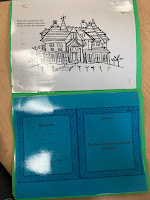Escape rooms are becoming more popular both in and out of the classroom. On weekends, people take their friends and families to escape rooms for fun. In the classroom, escape rooms are also becoming trendy. BreakoutEdu has digital breakouts that involve critical thinking skills. There are even Breakout kits where students can unlock and crack codes. Since The Thief of Always involves the main character being trapped inside and eventually escaping the Holiday House, I wanted to create an escape room that involved the book.
My school district follows the Lucy Calkins curriculum, and this story is the read aloud for Lucy Calkins 5th Grade Unit 4: Fantasy Book Clubs: The Magic of Themes and Symbols. After reading aloud the book to my class, I planned a breakout room in which students have to escape the Holiday House, the main setting in the book. I used skills from Lucy Calkins' Learning Progressions for this breakout. Students also use math, art, and critical thinking to solve the problems.
The breakout includes the following educational skills:
- Themes
- Character Traits
- Author's Craft
- Setting
- Perspective
- Internal & External Quests
- Converting Time
The clues also involve:
- Emoji Code
- Riddles
- Decoding
- Sketching
The full breakout is available for purchase on DiPasqua Education's Teachers Pay Teachers page. The package includes:Broke out of the Holiday House today! Breakout room for our Thief of Always read aloud! #TCRWP pic.twitter.com/5FDJVADBHl— Mrs. DiPasqua (@MrsDiPasquaOJR) June 3, 2019
- Lesson Plan with Breakout Directions
- Answer Key
- Student Map
- Student Answer Recording Sheet
- Breakout Clues
- Hint Cards
- Room Labels
- Escape Cards
Here's how it works:
I printed out and laminated all the materials. I sorted each of the challenges into folders, and labeled them with the appropriate room label. I acted as Mrs. Griffin, dressed in an apron, baring the "Mrs. Griffin" name tag.
I paired students in groups. This challenge can also be done in partners. Each group received a sheet to record answers, and a map. All students started with a folder containing the first challenge. Once students solved the first challenge, they came to me -- Mrs. Griffin -- to check their answer. If their answer was correct, that room on the map was stamped. They also received the folder for the next challenge. If their answer was incorrect, students kept working until they obtained the correct answer. Students kept working until they advanced through each of the rooms.
Students had opportunities to move to a different room if they were stuck. Before the breakout started, each group received a "Hall Pass" card, and with the help of the cats from the book, could move to another room. Students could redeem the card only once, so they were advised to use it only if they were really stuck. Students could also earn a "Hint Card" by completing bonuses for certain challenges.
If I noticed that groups were moving too quickly, I gave an individual from that group (typically the one giving the most help) a "Feast Card" so that they would have to sit out two minutes to "enjoy a meal" with Mrs. Griffin, since that was another big idea in the book. This allows other groups to catch up.
Once students solve all the riddles and get all their rooms on their map stamped, they breakout, right? Well, that's not 100% the case. Students then are asked to help another group escape. Just like Harvey went back into the House to help others escape, students are asked to do the same thing. When they help one group breakout, then they have officially escaped.
Students seemed to really enjoy the breakout. It is a change of pace from other regular activities.
If you purchase The Thief of Always Breakout, please leave feedback so we can improve for future updates!






